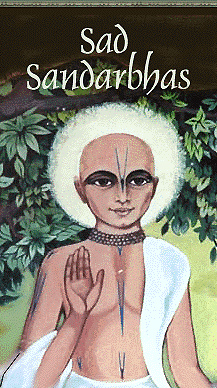
BY: SUN STAFF
Dec 9, CANADA (SUN) —
Tattva Sandarbha
by Srila Jiva Goswami
SECTION THIRTEEN
The Prabhasa Khanda of the Skanda Purana states therefore:
Previously, Lord Brahma, the grandfather of the demigods, performed severe penances and thereafter the Vedas appeared along with their Pada and Krama texts and their six limbs. Then the unchanging complete Purana, the embodiment of all scriptures, composed of eternal sound, sacred in nature, and consisting of one billion verses emanated from the mouth of Lord Brahma. Know that of the various divisions of that Purana the Brahma Purana is the first... (Sk.P. 2.3-5)
The figure "one billion verses" is mentioned here because that is the number of verses existing on Brahmaloka. The Srimad Bhagavatam, Third Canto, states, "Maitreya said, 'Beginning from the front face of Brahma, in order the four Vedas--Rik, Yajur, Sama, and Atharva--became manifest". (SB. 3.12.37)
And later on, "Then he created the fifth Veda--the Itihasas and Puranas--from his mouths, since he could see the past, present and future". (SB. 3.12.39) Moreover, the word "Veda" has been used here for the Itihasas and Puranas.
Elsewhere it is said: "The Puranas are the fifth Veda"; "The Itihasas and Puranas are called the fifth Veda". (SB. 1.4.20)
"He taught the Vedas along with the fifth Veda, the Mahabharata", (M.Bh. Mokshadharma 340.21).
If the Itihasas and Puranas were not Vedic then to group them as the fifth Veda in the preceding verses would be highly improper, since only objects of the same kind are grouped together. Also, the Bhavishya Purana states, "The Mahabharata is called the fifth Veda of Sri Krishna Dvaipayana Vyasa".
A reference is found in the Chandogya Upanishad of the Kauthumiya branch of the Samaveda (7.1.2), "O venerable Sir, I studied the Rig, Yajur, Sama, and Atharva Veda as well as the Itihasas and Puranas, which are the fifth Veda". Therefore, the well-known objection, that the Itihasas and Puranas listed in the Brihadaranyakopanishad 2.4.10 are included in the four Vedas and have no separate existence, is refuted. The Skanda Purana states, "The Brahma Purana is the first..."(as quoted previously).
Sri Jiva Toshani Commentary
Here Srila Jiva Gosvami substantiates the statement from the Brihadaranyakopanishad (2.4.10) which establish the Vedic nature of the Itihasas and Puranas by giving more evidence from the Puranas, Itihasas, and Upanishads. From these references the following is clear: 1. The Puranas and Itihasas have the same source as the four Vedas. 2. They are apaurusheya in nature. 3. They are in the same category as the Vedas and are in fact the fifth Veda.
Srila Jiva Gosvami here refers to a famous objection that the Itihasas and Puranas are part of the four Vedas. While explaining verse 2.4.10 of the Brihadaranyakopanishad some followers of the mimamsaka school hold that the words Itihasa and Purana refer to the historical passages found in some of the Vedas and not to separate works. For example, these sruti statements, yato va imani bhutani jayante, "From him these beings take birth etc."; sah brahmana srijati rudrena vilapayati hariradiranadih, "He creates through Brahma, destroys through Rudra, but Lord Hari is the source of all and is beginningless Himself etc." are all referred to as "Purana" since they pertain to creation and destruction, which is part of the subject matter of the Puranas.
They further argue that over an immense period of time many of these portions of the Vedas were lost and the available parts were difficult to understand. Therefore, as stated in Srimad Bhagavatam 1.4.25, out of mercy Srila Vyasa wrote the Itihasas and Puranas for the benefit of less-intelligent people in Kali-yuga. Hence the Itihasa and Puranas under discussion are part of the Vedas and not independent books hence it is incorrect to conclude that they are the fifth Veda.
Srila Jiva Gosvami refutes this with references from the Vedas, as well as from the Itihasas and Puranas themselves, to establish their rightful position as the fifth Veda, having emanated independently from the mouth of Lord Brahma. If they were only parts within the Vedas then there was no need to call them the fifth Veda in the references cited. In addition, the Samhitas, Brahmanas, Aranyakas, Upanishads, Kalpasutras, Dharmasutras, Grihya Sutras, Puranas, Itihasas, and other smriti texts have many references about the Itihasas and Puranas being apaurusheya and Vedic in nature. Except for the last three the rest are all different portions of the original four Vedas. Some of these references are:
"The Rig, Sama, Yajur, and Atharvaveda, along with the Puranas, and all the demigods residing in the heavenly planets appeared from the Supreme Lord." (Atharvaveda 11.7.24)
"He moved favorably towards Brhati and thus the Itihasas, Puranas, Gathas, and Narasamsi became favorable to him. One who knows this verily becomes the dear abode of the Itihasas and Puranas, Gathas and Narasamsi". (Atharva 15.6.10,12)
"In this way all the Vedas became manifest along with the Kalpas, Rahasyas, Brahmanas, Upanishads, Itihasas, Anvakhyatas and Puranas". (Gopath Brahmana Purva 2.10)
"Indeed Rig, Yajur, Sama, and Atharva are the names of the four Vedas. The Itihasas and Puranas are the fifth Veda." (Ch. U. 7.1.4)
"One who studies thoroughly the Vedas along with it's six limbs and the Itihasas and Puranas becomes a true knower of the Veda. (Vyasasmriti 4.45)
In the next anuccheda Srila Jiva Gosvami explains why the Itihasas and Puranas are counted as the fifth Veda.
Go to Section Fourteen
Return to Section Twelve
